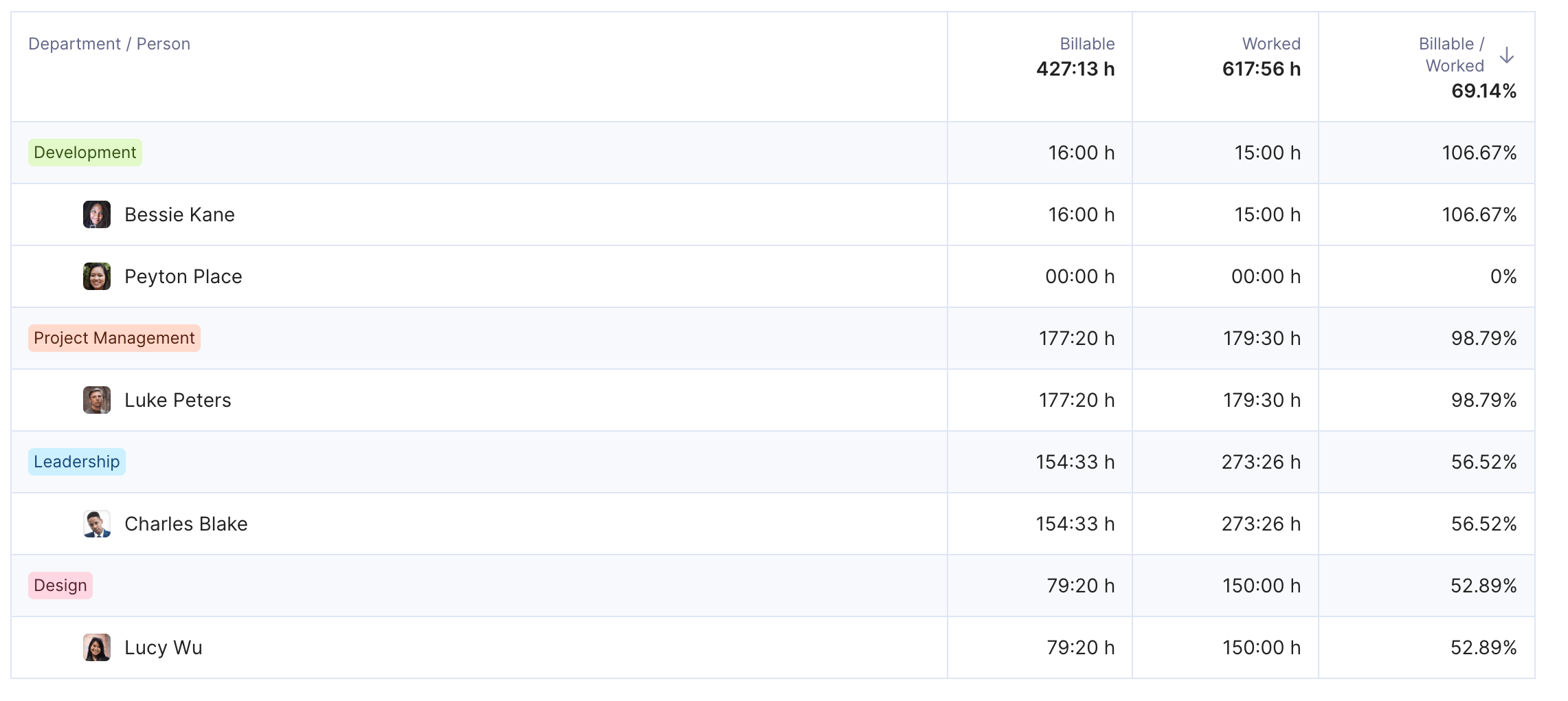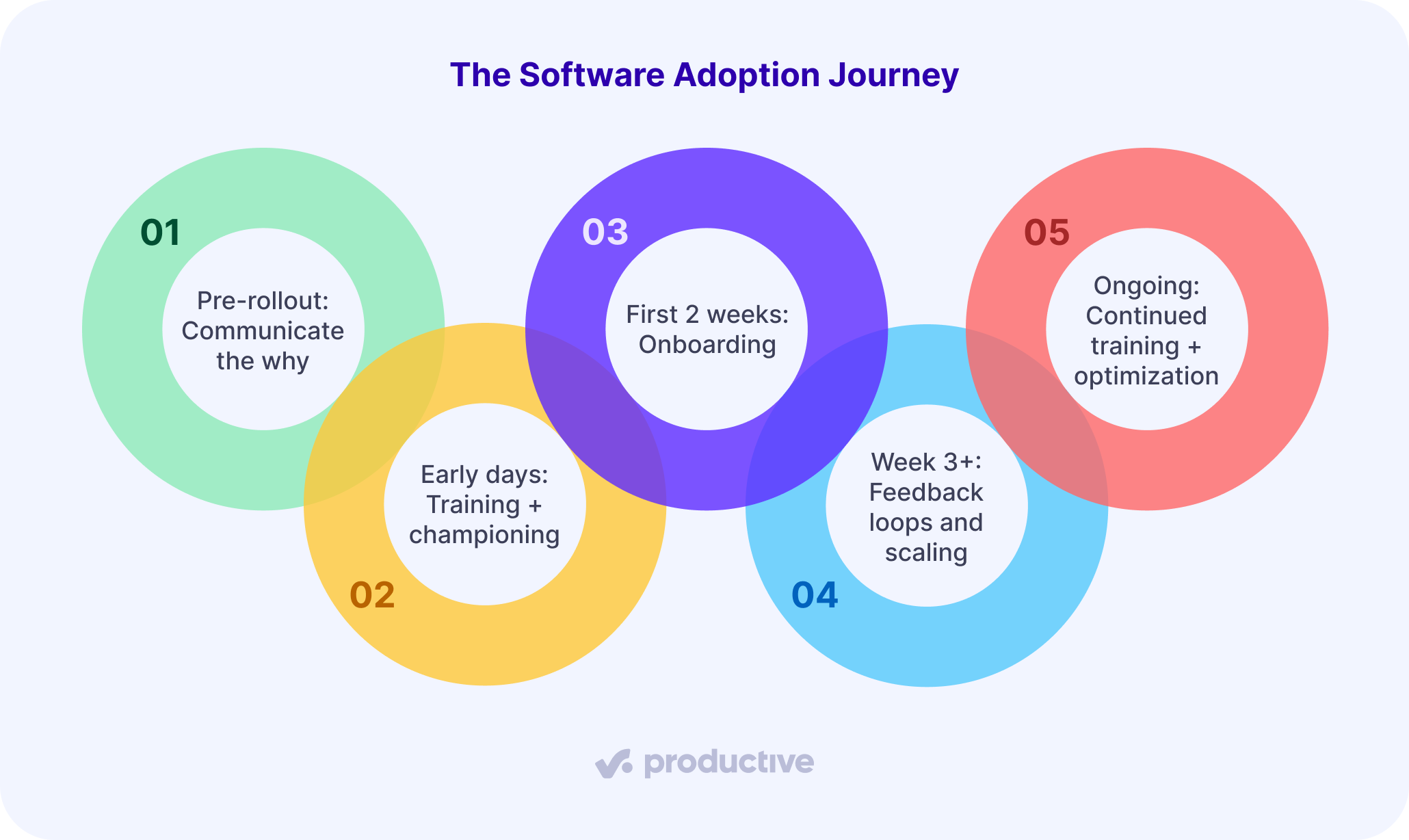7 Strategies to Boost Your Team’s Software Adoption

Software adoption takes more than handing out logins and wishing everyone good luck. Learn how to turn your team from skeptical bystanders into confident users – and make sure your investment in a new digital tool actually pays off.
“ANOTHER new tool?”
“Why are we changing something that works?”
“Is this going to be complicated?”
– Team members everywhere
Rolling out new software in an organization can be tricky. We all rely on a number of digital tools in our work, and adding a new one is a disruption – a disruption to our workflows, our habits, even the mental models we’ve built around them. (“But this is how we’ve always done things!”).
However, sometimes the tool is worth the disruption. Sometimes the switch is exactly what you need to become more efficient, create more value, and make everyone’s lives easier in the long run. But how do you get past the software adoption hurdles and reach that idyllic future where teams and tools work in unison?
At Productive, we’ve supported hundreds of companies through setup and onboarding, and we’re sharing our best practices to help you rock this rollout.
What We Mean by Software Adoption
Software adoption is the process of getting your team to actively and consistently use a new software application as part of their daily work. It’s not a matter of handing out logins and showing everyone where the dashboard is – the goal is to help them understand the tool, see its value, and learn how to integrate it into their workflows.
Unlike product adoption in SaaS (which focuses on end-users and markets), this is about internal user adoption – getting your own people on board.
Why Software Adoption Matters
Because tools can only bring you value when people actually use them.
Teams can sometimes resist change, and how you approach the initial introduction will have long term-effects for software adoption. Failing to handle it right can easily turn that initial skepticism into rejection – wasting time, money, and momentum, while your team misses out on the very benefits the tool was meant to bring.
And nobody wants to fall back on spreadsheets and fragmented tools.
What We Won’t Cover and Why
If you googled this topic or asked your AI chatbot of choice, you might’ve seen frameworks like the “5 stages of technology adoption” or metrics like feature adoption rate. Those are useful in other contexts – like SaaS product launches or tracking go-to-market success.
But if you’re concerned about software adoption within your team or organization, they’re a detour. Here, we’re skipping the theory in favor of practical, proven strategies that will help your team not only embrace the new tool, but wonder how they ever lived without it.
7 Proven Strategies for Better Software Adoption
#1: Explain the Why Behind the Tool
Rolling out new software without context is a surefire way to spark resistance. Of course you think it’s the best thing since sliced bread – but you’ve done the research, sat through demo calls, and gotten familiar with the tool’s capabilities. For your team, this may be the first they’re hearing of it.
People need to understand why the change is happening. What problem are we solving? What’s the end goal? How will this tool make work easier or better?
With Productive, for example, the message to end users is simple: instead of switching between multiple tools, they’ll be able to do most of their day-to-day work in one place – from tracking time and updating projects to requesting time off. Plus, the interface is easy to get used to, even for less tech-savvy team members.
So, before you send out a company-wide email with “We’re rolling out new software, yay” in the subject line, get your change management hat on and communicate the bigger picture to your team. Once they understand the why, they’ll be far more likely to get on board with the how.
The Why Behind Time Tracking

Time is your most valuable asset — tracking it reveals where profit is made.
If there’s one feature that needs a clear “why,” it’s time tracking. It often meets resistance (looking at you, creatives) because it can feel like micromanagement or pointless admin. But when done right, time tracking is one of the most powerful tools a business can adopt – it’s the backbone of utilization, planning, and profitability.
When you know where time is actually going (not just where you think it’s going), you can distribute workloads more efficiently, plan projects more effectively, and understand which work is profitable, and which less so. This enables better decisions across the entire organization, from hiring and resourcing to pricing and forecasting.
#2: Appoint Internal Champions for Key Areas
There’s no need to hire LinkedIn influencers to drive user adoption – your best advocates are already in the building. Internal champions make software adoption smoother by leading from within.
At Productive, we suggest appointing champions for each key area like project management, budgeting, time off, and resource planning. These are typically the people already managing those processes: project managers, HR admins, department heads, and similar roles.
Champions:
- Act as the bridge between software provider and team
- Use the platform first and receive training
- Share updates and tips in a familiar voice
In Productive, you can appoint champions directly in the settings – making it easy to give them the right visibility and responsibilities from the start.
This setup is great for adoption because champions can explain how the tool actually fits into their team’s specific workflows. Plus, even the most skeptical team members are more likely to get on board when the information comes from someone they know – and maybe share a coffee break with.
#3: Take the Time for Training and Education
Just like leg day – don’t skip it. Onboarding to a new digital tool is a process, and a crucial one. If your team doesn’t learn how to use the software properly, they won’t get as much value from it, and they’ll likely dismiss it as useless.
Handing out logins, dropping a few tutorial links, and wishing everyone good luck isn’t enough. A proper onboarding process requires time, focus, and structure. That means giving your team the space to learn and explore without feeling like they’re squeezing it in between five other tasks.
And besides taking the time for onboarding, we also recommend not wasting any time. Ideally, onboarding should be done within the first two weeks after implementation. It’s a lot of new information to take in – and information we don’t put to use tends to evaporate quicker than free snacks in a coworking kitchen.
Onboarding with Productive: What It Looks Like
At Productive, onboarding starts early – on the very first calls. We ask about your workflows, goals, clients, and what success looks like, so we can tailor demos and guidance to your needs. We set up mock projects and processes aligned with your day-to-day.
We also offer (and highly recommend) guided onboarding, especially to larger organizations with complex processes. This includes a series of focused sessions on core areas like budgeting, resource planning, project management, invoicing, and more. All sessions are recorded so they can easily be shared internally.
For those who prefer a self-serve approach, we’ve prepared plenty of resources:
- Quick Start: Built into the dashboard, it helps new users practice basic features hands-on
- Sandbox Mode: A safe testing environment for trying out features without affecting real-world data
- Help Center: A comprehensive hub with how-to guides and answers for everything Productive
- Tooltips: Hover-over explainers providing in-app guidance with links to help articles that open in a chat bubble – no context switching required
- Customer Support: Our highly rated support team – both AI and human – is available to help whenever you need it.
- Productive Academy (coming soon): A set of tutorials and videos – complete with certification
Whichever path you choose, this is the takeaway: don’t underestimate the importance of onboarding for software adoption. The time you invest upfront pays off results later on.
#4: Start Small — But Start Immediately (The Incremental Rollout)
You don’t need to turn the entire company upside down overnight. You know your people best – their strengths, skills, and current workload – so you can assess how much change they can handle at once.
Some organizations opt for the cut-and-freeze method. They choose a firm go-live date and switch all active projects at once. This doesn’t mean there’s no preparation – the move is usually preceded by a few weeks of meticulous setup, where we help define workflows and prep the team. The benefit of taking this approach is that there is no messy duplicate effort across two tools.
For other teams though, a gradual rollout works best for long-term user adoption. Start small – maybe it’s one feature, one team, or a few active projects. Let people dip their toes before you ask them to dive in. Just don’t delay that first step. The key is to start using something right away, so the habit starts to form early.
For example, introduce scheduling to managers first. Or have your team begin tracking time and updating one live project in Productive. That gives them space to get comfortable, ask questions, and build confidence without the chaos of a full switch on day one.
Both methods work – what matters is that you commit to the first step and make it real.
#5: Create Custom Guidelines

There’s more than one way to crunch the numbers. Just make sure everyone’s using the same formula.
Learning how to use a tool is one thing; learning how your team is expected to use it is another. Many software adoption issues don’t come from people struggling with features, but from not knowing when to use them, how, or why.
That’s why we always recommend creating a simple internal handbook that lays out your company’s specific rules and workflows. This might include how to name projects, when to update budgets, who’s responsible for what, or how time entries should be categorized.
This is especially important with a flexible platform like Productive. It’s designed to be used by all sorts of businesses offering professional services, from software development companies to architecture firms. There’s no single ‘correct’ way of using Productive, which is why your guidelines are your team’s North Star.
Pro tip: You can create your internal handbook directly in Productive Docs. Add videos, screenshots, and custom instructions; leave comments for updates or clarifications. This way, you’re building a living, team-specific guide that’s always accessible when someone needs a refresher.
#6: Ask for Feedback – Then Act on It
Asking your team for feedback seems like a given, but many still skip this step or treat it like a one-time checkbox. Regular check-ins, especially early in the software implementation phase, are very important for long-term adoption.
What’s confusing? What’s missing? What could make the experience smoother? You want to create a feedback loop where people feel heard, and they can be assisted if there’s anything unclear.
At Productive, we’ve built this feedback loop into our process. A dedicated Customer Success team is there to follow our customers throughout their journey. We also run regular business reviews; quarterly, biannually or annually, depending on your needs.
These sessions give us insight into how your team is using Productive. We look for opportunities for improvement and score your setup, helping you get the most value from the platform.
This is also a chance for us to discuss new releases, feature requests, and wishlist ideas. We always pass these insights to our product team – and feedback often turns into actual features.
#7: Don’t Forget Continued Training
Onboarding isn’t a one-and-done deal. New features are released, workflows evolve, and team members join. Keeping everyone in the loop makes sure you’re getting full value from the tool and maintaining strong user adoption.
At Productive, we ship updates often – and many of them are entirely new functionalities based on customer feedback (see the point above). We also host webinars and share roadmap insights that are great touchpoints to re-engage your team and help them level up their usage.
When new team members join, make sure they get the same level of onboarding as your original crew. Recordings from your initial training sessions or internal playbooks can help bring them up to speed quickly and consistently.
Encourage exploration. Highlight new features and make learning a part of your culture. After all, the tools work best when everyone knows what they’re capable of.

Start with the ‘whY.’ end with Full adoption.
Common Software Adoption Challenges (And How to Beat Them)
Sometimes, even if you approach the rollout process with utmost care and follow all the recommendations, you may hit a few bumps in the road to stable software adoption. Here are some of the usual suspects:
“This feels like extra work”
Onboarding to a new tool shouldn’t be a burden. Make the process as easy as possible for your team. Don’t pile it on their existing workload, secure guidance and support, and go incremental if needed.
Low executive buy-in
If leadership treats the tool as optional, so will everyone else. Do some internal marketing (focusing on the why!), and encourage your managers to track, plan, and collaborate in the tool as well. Your exec team should be modeling adoption, not just mandating it.
No internal ownership
If everyone’s responsible, no one is. Assign clear owners to each part of the implementation and ongoing training. Champions (see Tip #4) are your glue here – they help build trust and keep momentum going when novelty wears off.
Misalignment between tool and team needs
The strength of flexible tools like Productive is that they can be fully customized to the needs of your organization. Make sure to set up the software so that it aligns with your workflows (we can help – that’s what we do on onboarding calls). That way, your team doesn’t have to reinvent how they work. They just need to learn where their work lives now.
Treating adoption like a one-off event
This is not a launch party, it’s a lifestyle shift. Regular check-ins, ongoing training, and roadmap updates help your team adapt as the tool (and your business) evolves.
Bottom line: software adoption challenges aren’t bugs in the system. They’re normal human reactions to change. Anticipating them – and having a plan to work through them – is half the battle.
Software Adoption for Professional Services: What Makes It Different
Adopting software in a professional services business comes with its specifics – especially if we’re talking about a base platform that bundles all your operation-critical features. You’re managing internal workflows, but you’re also managing client relationships, billable time, and people’s calendars down to the hour. Stakes are high, margins are tight, and every inefficiency eats into profit.
In this context, software adoption is an important factor in your broader digital transformation. One that aligns your tools, teams, and clients around shared systems and real-time visibility.
Here’s what makes adoption in this space a little different:
Billable time is sacred
Your team isn’t paid to test software. Every minute they spend fumbling through new features is a minute not spent on client work. That’s why your adoption plan needs to be surgical – fast, relevant, and clearly connected to outcomes like more accurate forecasting or less time spent on reporting.
Processes vary wildly across teams
Designers, consultants, account managers, and ops don’t work the same way – and they shouldn’t be trained the same way either. Your onboarding and documentation need to reflect those differences or you risk leaving half the company behind.
There’s often an existing patchwork of tools
Professional services businesses tend to be “tool survivors” – they’ve made it work with spreadsheets, whiteboards, Slack threads, and legacy systems. So software adoption isn’t starting from zero. Your goal is to prove why this new solution is better than the messy status quo. And yes, sometimes you’re fighting nostalgia.
Adoption is an internal matter – that also affects clients.
In Productive, clients may view project updates or budget usage, depending on what you choose to share. How your team adopts the tool will have a direct effect on what your clients are seeing – and you want that to be accurate and professional-looking
The good news is that when adoption works in professional services, it really works. It may seem like a simple tool switch, but we’ve seen businesses transform by making it.
Ready To Roll?
Adopting new software doesn’t have to feel like dragging your team through digital molasses. With the right strategy, communication, and support, it can be an empowering process that ultimately levels up the way your team works.
If you’re considering Productive as your next tool – whether for project management, resource planning, budgeting, or just not cursing at spreadsheets anymore – book a demo and we’ll show you how it can work for your team.
